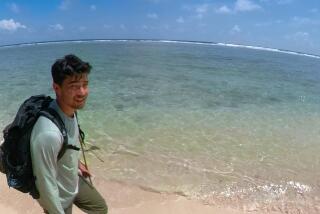‘Rapa Nui’ Misuses Its Literary License
- Share via
In his recent review of Kevin Reynold’s unfortunate film “Rapa Nui,” critic Kenneth Turan is rightfully amused by the “goofy” dialogue and “giddy South Seas” fantasy quality of this “throwback to Cinemascope epics of a simpler time” (“ ‘Rapa Nui’ Presents a Fantasy Island of a Simpler Past,” Calendar, Sept. 9).
The extremely small audience of which I was part hooted and jeered, not only at the cliched dialogue but at the transparently phony melodrama. In fact, I thought New Zealand actor Eru Potaka-Dewes as the silly ariki mau was hilariously funny, and some of his scenes with George Henare (the evil priest) approached the unintended level of Three Stooges comedy. I concur with Turan in his negative view of the film, but write to take issue with him on two points.
First, I think his willingness to view some of the footage as “good fun in a Saturday-matinee way” is generous but inappropriate and uniformed. The footage he is most impressed with portrays the ancient tangata manu or “birdman” rite. This profoundly sacred ritual ordeal is totally misread by director-writer Reynolds, who treats it as a crassly undertaken, viciously competitive “ironman” contest. While dramatic and daringly filmed, this ridiculous sequence betrays a profound ignorance of Polynesian ritual and Rapa Nui belief.
Second, Turan fails to note the pseudo-documentary disguise this film wears. At the beginning we are told, in a voice-over thick with dramatic import, of the Polynesian settlement of Rapa Nui. At the end, a tagline states unequivocally that “archeological evidence” proves that Pitcairn, lying some 1,400 kilometers westward, was settled from Rapa Nui. This is a patent falsehood that cannot go unchallenged.
*
Pitcarin Island was once inhabited and then abandoned by Polynesians, as were several other Pacific islands. There is virtually no hard evidence of any kind to demonstrate that Pitcairn or any other East Polynesian island was settled from Rapa Nui. While we may rationalize away, if we choose, the “artistic license” this film’s creators have taken with Rapa Nui history (“Does ‘Rapa Nui’ Take Artistic License Too Far?,” Calendar, Aug. 26), such deliberate distortion of scientific fact (or ignorance of its existence) is totally indefensible.
Much ink has been spilled in the concerned scientific community about this film’s huge negative impact on the island’s natural and cultural environment. In some ways, all of the turmoil would have been bearable if a good film had resulted, a film that did justice to the sacrifices made and gave honor to the past. Rapa Nui, which is an especially artistic culture, had a right to expect more.
Rapa Nui has always inspired artists, writers, adventurers and scientists. Thor Heyerdahl sailed the Kon-Tiki on a wave of publicity into the imagination of two generations of travelers. No less a talent than Robert Frost wrote a poem about one of the monolithic statues. But the island, because of its incredible megalithic accomplishments and dramatic isolation, also has been the reluctant center of fantastic speculation, bad research and pseudoscience. This film not only contains most of the discredited and discarded myths once advanced about the island, but some of the newer unreasonable and unproven speculations as well.
It is but the latest in a long and lamentable history of drivel written about Rapa Nui.
More to Read
Only good movies
Get the Indie Focus newsletter, Mark Olsen's weekly guide to the world of cinema.
You may occasionally receive promotional content from the Los Angeles Times.










